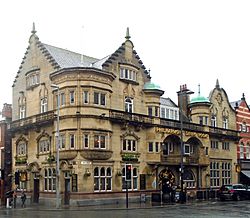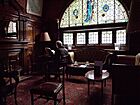Philharmonic Dining Rooms facts for kids
Quick facts for kids Philharmonic Dining Rooms |
|
|---|---|
| Native name The Phil | |

Philharmonic Dining Rooms
|
|
| Location | Hope Street and Hardman Street, Liverpool, Merseyside, England |
| OS grid reference | SJ 356 899 |
| Built | 1898–1900 |
| Built for | Robert Cain |
| Architect | Walter W. Thomas |
|
Listed Building – Grade I
|
|
| Designated | 12 July 1966 |
| Reference no. | 1207638 |
| Lua error in Module:Location_map at line 420: attempt to index field 'wikibase' (a nil value). | |
The Philharmonic Dining Rooms is a famous old pub in Liverpool, England. People often call it The Phil. It's a very special building, listed as Grade I. This means it's super important and protected because of its history and amazing design. You can find it on the corner of Hope Street and Hardman Street, right across from the Liverpool Philharmonic Hall.
Contents
A Look Back in Time
This beautiful building was built around 1898 to 1900. It was made for a brewer named Robert Cain. The person who designed it was an architect named Walter W. Thomas. Some skilled artists from the School of Architecture and Applied Arts at University College (now the University of Liverpool) also helped.
A very famous musician, Paul McCartney from The Beatles, performed here when he was young. He even gave a surprise concert at The Phil in 2018!
Amazing Architecture
The Philharmonic Dining Rooms is known for its unique and fancy design. It's built from stone with a slate roof. The style is very "exuberant," meaning it's full of exciting details.
Outside the Building
The building has parts that are two storeys tall and parts that are three storeys tall. It also has attics and a cellar. Along Hope Street, there are ten sections, and along Hardman Street, there are three.
You'll see many different kinds of windows on the outside. Some have special frames called architraves. There's a cool two-storey window that sticks out at the corner where the streets meet. Look for the stepped gables (the triangular parts of the wall at the end of a roof) and small turrets with rounded tops. There's also a fancy railing above the second floor and a curvy balcony over the main entrance. You can also spot a sculpture showing musicians and instruments. The main entrance has beautiful metal gates in a style called Art Nouveau.
Inside the Building
The building has five floors in total. The main bar area inside is decorated with musical themes. This is because it's so close to the concert hall. These decorations include special copper panels and plasterwork. You'll also see mosaics and items made from mahogany wood and glass.
Two smaller rooms inside are named after famous composers, Brahms and Liszt. Many visitors are interested in the very fancy gentlemen's washrooms. They have pink-marble sinks and pink imitation-marble wall coverings.
-
Art Nouveau gates in main entrance
Why It's Special
Experts say that The Philharmonic Dining Rooms is the most richly decorated pub from the Victorian era in Liverpool. They even say it's "of exceptional quality in national terms." Being a Grade I listed building means it's considered "of exceptional interest." It's truly one of Liverpool's "architectural gems."




